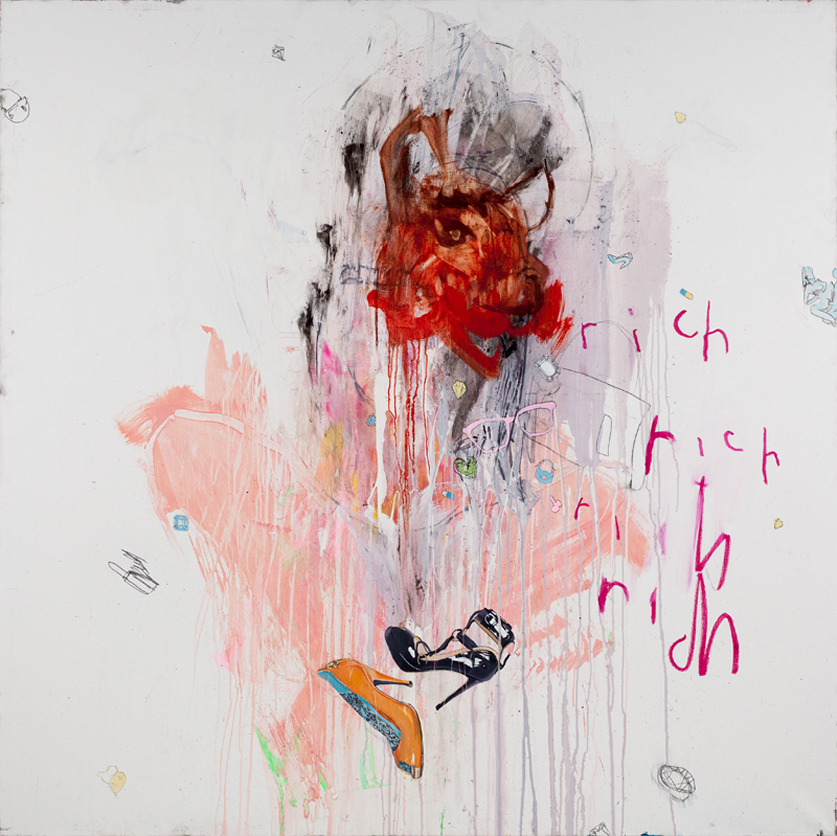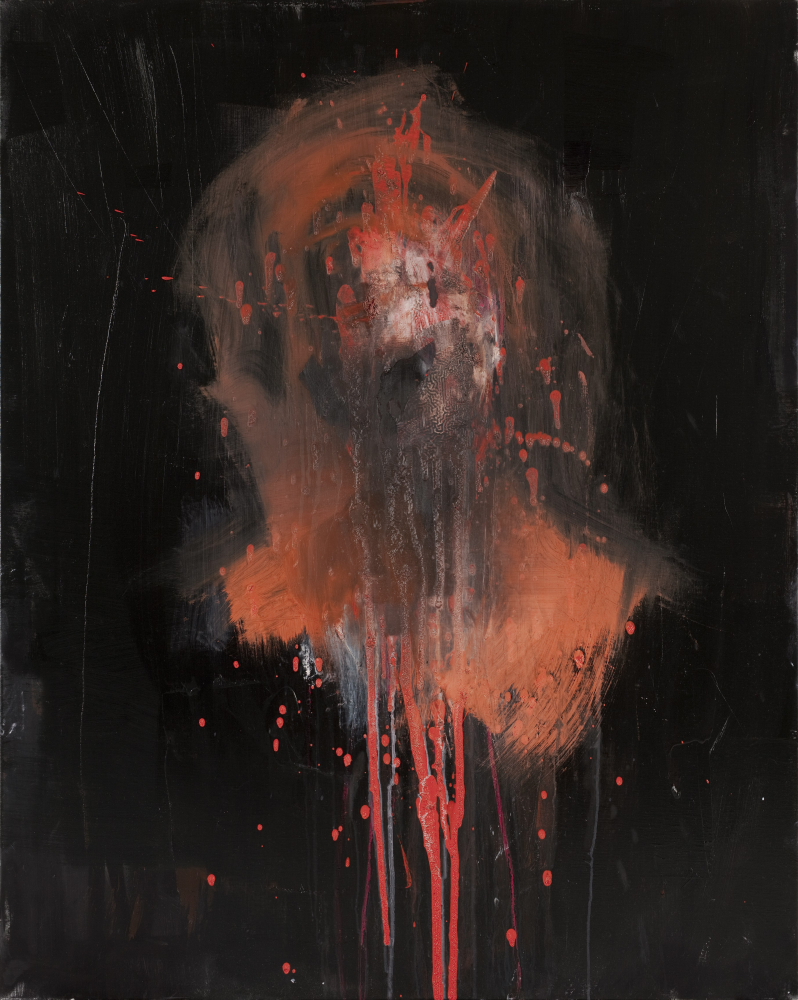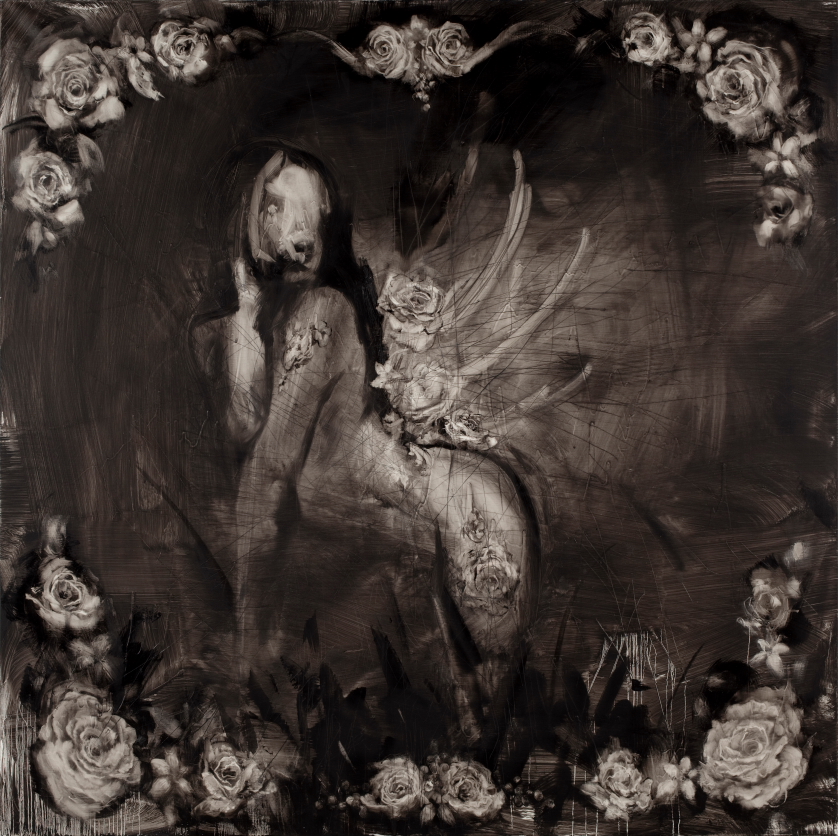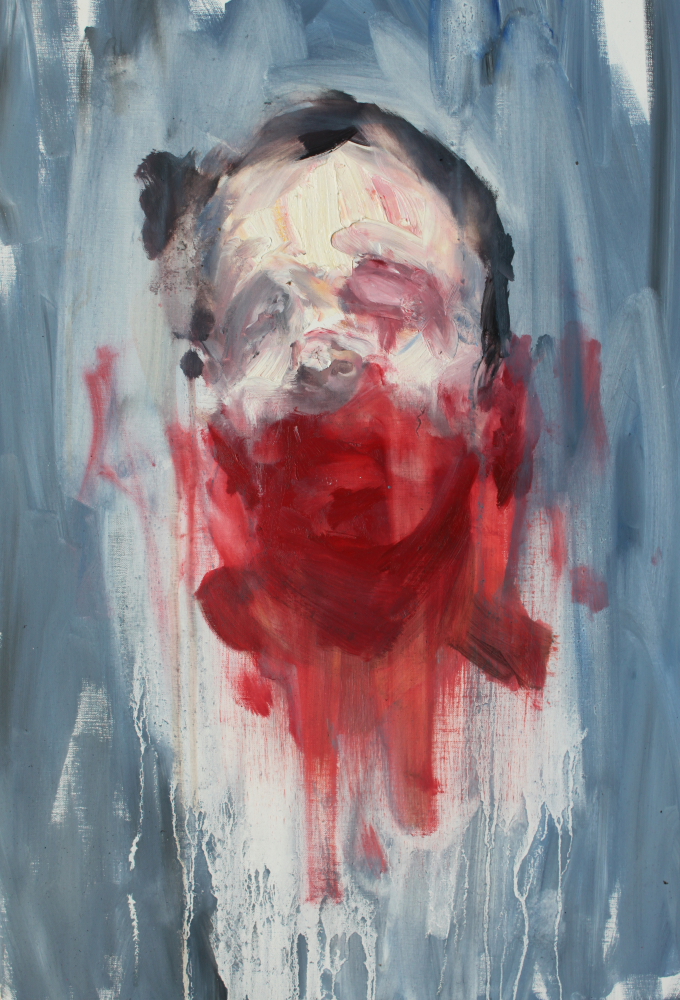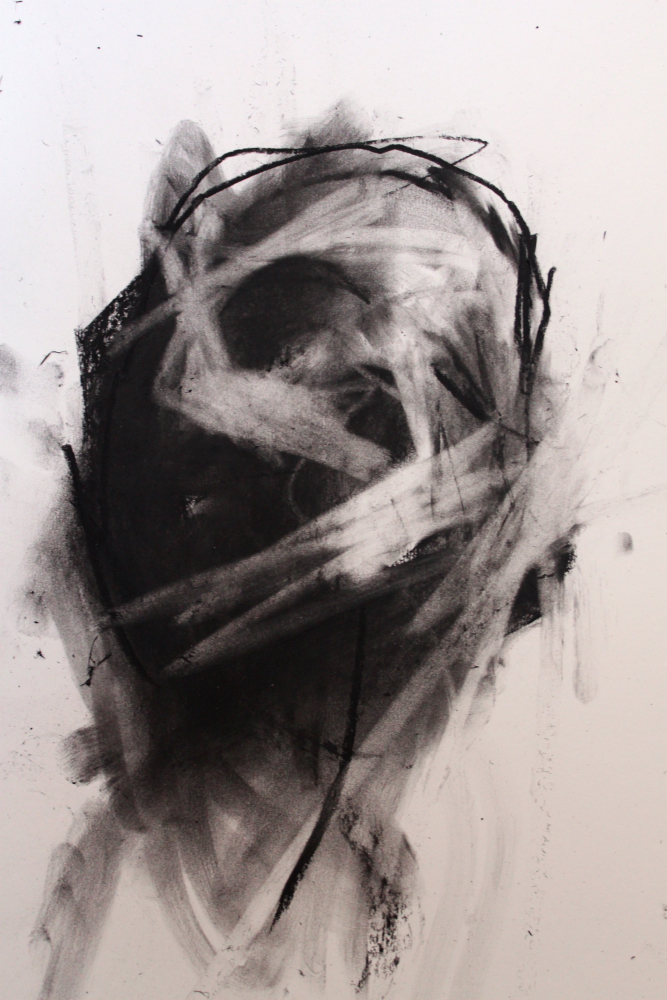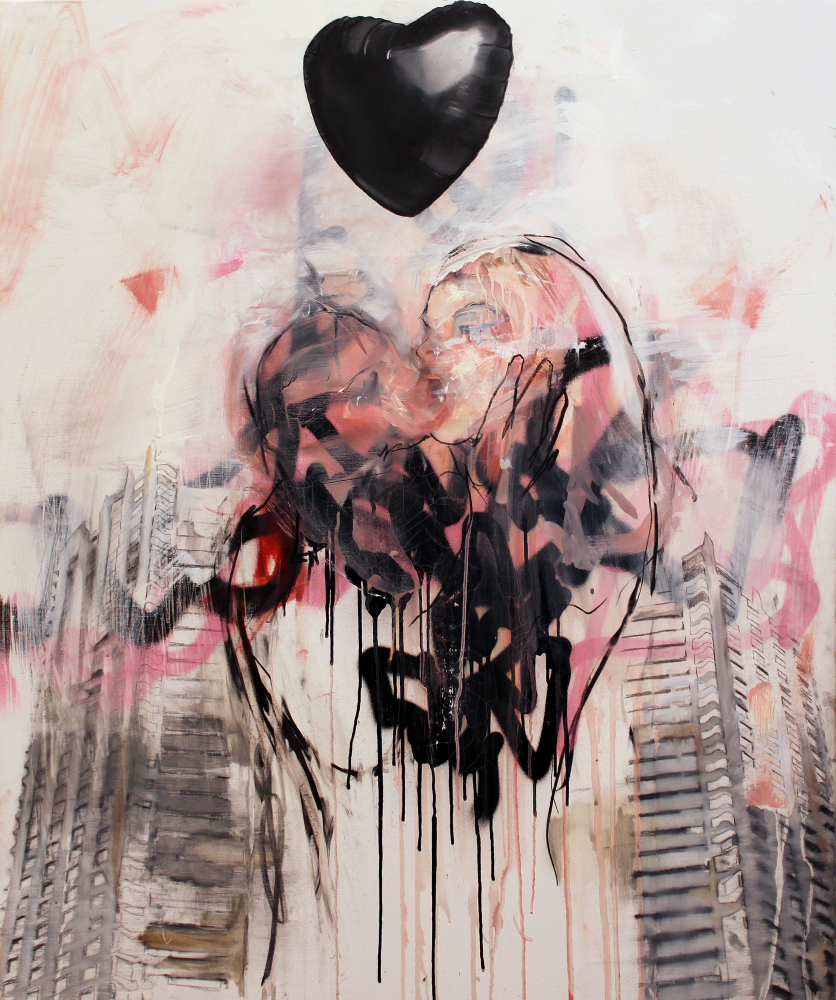One of London’s most anticipated shows of the year is almost upon us with Antony Micallef’s “Becoming Animal” opening this week at Lazarides gallery’s Rathbone Place location. We certainly got excited after seeing the new image of one of the show pieces he recently put on his website here – and it certainly seemed to fit with the dark tone he described to us. This is the first solo outing from Micallef since his sell out show in Los Angeles, “Impure Idols,” in 2007 where the entire show of 50 paintings sold out within just two hours of opening. Antony was in a relaxed mood after working solidly for over a year on the new body of work when AM sat down with him to talk a little about the show over a beer a couple of weeks ago.
Read on for the interview and further preview images after the jump.
Arrested Motion (AM): Firstly Antony, many thanks for taking the time to speak to us ahead of the upcoming show. We understand that the new work is taking on a different direction from previously seen paintings, but so far the new show has been kept pretty much under wraps, we’ve not even seen if there is a title for the exhibition yet. Does the new body of work have an umbrella title?
Antony Micallef (Ant:) I kind of don’t want to give away too much before the show. I think everything is really interlinked. The kind of work I’ve been doing, it kind of relates back to some of my earlier work I was making ten years ago – I’ve revisited some of that subject matter – the cross referencing of different animal species with people.
I’ve been living in London and you have good times and bad times when you are here – it’s kind of autobiographical as well. It’s quite a personal show and I think the work I’ve made, and it feels really good to say this, but without blowing my own trumpet, it feels like the best work I’ve ever made for me personally. I’m just trying to get back to painting that actually feels really good. It’s less about messages and very different from the show I did in LA. For me, it’s more about painting and exploring paint – and taking that as far as I can go – and that has been a lot of fun.
Sometimes when you are working on a piece, you can get it to 80% and you think, well, I can push this a bit more and get it to 90%. But if you can get to that 97%; that’s when the gems start coming out – but that’s quite rare, and occasionally when you do that and you try and get that little bit of extra – you’re at 90 or 95% and it just needs that little bit more, just needs a tweak, but some of the time you can kill it. I’m really happy with the work I’ve done for the show – I’ve destroyed a lot of work in the process of making this, it’s just over a year’s work so I guess when you have that time, it gives you the opportunity to really go for it. If you let things go that you are not really happy about, they can come back and bite you on the arse…
AM: So when you say you’ve destroyed a lot of work, do you mean you’ve over-painted….
Ant: Yeah, yeah. It’s quite funny because I started some of the pieces over a year ago and one of them was going to be this massive head, but it just wasn’t there… I’ve got a few canvases like this that I’ve just left around the studio. You don’t know what to do with them and it’s really weird with this whole time thing, but after a while, you understand what to do with them. If you have a canvas that’s been worked to death, I generally just put some primer on top and it will drip down or whatever. One day you’ll be back into the zone… I mean you might need an extra piece somewhere and you find this canvas that’s been reworked and you can paint on top of that. Something completely different may come out of it, and the working from a year ago then works well with the new painting. It’s a lot more considered without it becoming stale.
AM: Is there any particular spine of narrative that is running through the pieces? Do you see it as a cohesive body of work?
Ant: All of this work definitely belongs as a group to a body of work. I think that when you see the show you’ll see they all relate, they all correlate with each other. As I said before, it’s very different than the LA show. It’s weird as I have ideas in my head now of new things I want to do which seem completely different, but it’s a really dark show. It’s funny because when you’re making work like that for a while, you can only really do that sort of stuff for a period of time before you need to do something completely different. Before that I did this massive painting for the Royal Academy…
AM: That was the ‘Parasite’ piece?
Ant: Yeah, and that was a really dark piece as well. I wouldn’t say the work is similar to that, but to me, it’s equally as dark in other ways. You have to dip in and dip out – you can’t keep doing that forever. It’s like wearing the same clothes all of the time – you’ve just got to make a change, so all of my next paintings are going to be really fluffy (laughs).
AM: So you don’t want to put yourself in a permanently dark place then?
Ant: No, I need a break! Whenever I try and paint fluffy stuff it’s quite funny because after a while, you find yourself putting dicks on everything! And things getting stabbed, and you feel like ‘oh no!’, but maybe that’s just a reaction I get from being too fluffy.
AM: As a visit to Tokyo previously informed some of your earlier work, is there a particular event or inspiration behind this new work? You mentioned earlier when we were chatting that the work is based around your experiences of now being based in London.
Ant: Really it’s about looking at people again. There are a lot of heads in the show. Compositions of figures. I guess in the beginning with the whole Japanese thing, for me that was the start of having the influence of the colour and the madness. Before that, all of my paintings used to be very ‘London School’ with single figures. When I went to Japan it was like ‘bang!’ – you can’t help but be influenced. It was like someone saying you can do all this now, because I saw it first-hand. With this show and it being darker, there are still colour references here and there. It’s quite a mature show for me – I think the painting is a lot more mature and with the mark-making; I think I’ve just got better through time, through painting. The more you do it, you just get better. It’s less about messages and more about painting.
AM: Is there any piece that stands out for you either as a favourite, or one that you’ve had a particular experience in creating?
Ant: I’ve actually got quite a few favourites. One of them is called ‘Siren.’ Sometimes you make these paintings – and these types of paintings come once every 3 or 4 years – where you start painting and things flow and just come together. Then you step back and think how the fuck did I make that? I’d started to re-create it in other areas or get bits of that into other pieces, but it just hasn’t worked. Those paintings come together every 3 to 4 years and it’s weird because you kind of feel a bit fake afterwards as I don’t know how I did it, but that’s the beauty of those pieces and that’s why I consider them as ‘gems.’
AM: Like writing a song that you know is going to be a number-one single.
Ant: Yeah I guess – they are kind of like just channeled through you in a sense. I call it action painting. You can be painting away and you’ve got your cloth and your brushes, the paint’s dripping and you’re picking up the canvas and dropping it on the floor…. It’s all about that moment. It’s going so fast, but if you stopped and considered what you are doing, you’d fuck up. I guess if you are on a bike and you go off a jump or something and then you land and think ‘how the hell did I do that?’ You can’t set these points apart – they just arrive. There’s few paintings in the show for me where the work has just ‘arrived,’ and for me that’s why it’s a special show and I’m really happy about every single piece, which I’m glad I’m able to say.
AM: In terms of scale, how are you approaching hanging the show? Rathbone Place is pretty huge, but then so are some of your paintings. Are you taking on multiple floors of the space?
Ant: Well, I’ve definitely made enough work for it to sit well within the gallery. I’ve made a lot of work this year, and every piece I’ve made for the show I don’t mind showing at all, but at the same time, certain pieces will work better with other pieces. I almost see it like putting an album together – having a certain piece sitting next to another piece and you can make connections with the individual works.
AM: Yeah, I’ve talked to other artists before about this sort of comparison. An artist I spoke to recently told me, he thought of pieces he made for a solo show equating to chapters of a book, but then when he was making an individual piece for a group show, then it was its own short story.
Ant: Completely, and you can apply that same philosophy to an album or a single. There are pieces in this show which need to be in a solo show. There are certain pieces which will work fine by themselves. I’m not saying the other pieces don’t have the strength, but they correlate with the other pieces and make sense when they are put together.
AM: And will there be a selection of differently sized works? Perhaps some of a more modest size included?
Ant: There is a range of sizes within the show, going from this size (approx 10×12 inches) to this size (stretches arms full width). There is black and white work, there’s colour work too. I’ve always felt that some of the black and white work, some of the heads for example, are a lot stronger than the colour pieces, but this year I’ve really tried to make a point of, like I said earlier, really trying to get back into painting. The colour has worked equally as well as the black and white stuff.
AM: On the subject of monochrome paintings, you were tutored by John Virtue, who quite famously said that the use of colour was ‘an unnecessary distraction.’ From what I understand, he didn’t lecture per se. How did he work with you and how important was he in helping you find and develop your style?
Ant: He was really important to me because he didn’t take any bullshit at all! So if I’d been painting from photographs, he come into my space and literally rip them off the wall. I knew why he was doing that, and it forced me to work from life. Whenever I paint any heads on any painting even when it is embodied, I always paint from life. I have a mirror next to the canvas, angled where I’m painting. There’s something about painting from life that you just can’t get from a photograph. When you draw on the paper, it’s almost like sculpting, but using a bit of charcoal, a pencil or a brush. I consider painting like drawing, but you’re just drawing with paint. It’s the same thing to me for the kind of painting I do. John was brilliant. He was really into Frank Auerbach and those kinds of painters who used that really visceral style of painting. John could be looking at your work and you could be telling him what’s going on in the painting, but he would be like ‘Well, I don’t care. That’s fine but that’s just what‘s going on in your head not on the canvas?”
You know when you go into a gallery and there’s a page of A4 explaining what the work is all about? Well, I feel that if you’ve chosen a 2D language as your medium to communicate, then you have to do that with the pictures. Sometimes, the words help a bit and you can read it and think ‘I see what you are doing now,’ but I want to understand it by the medium the artist has chosen to tell me by.
You know if you listen to a Nirvana song, and you get those shivers down your spine? No one has told you or explained to you why you get those shivers – you just do. It’s instinctive, and for me, that is the best type of art. That’s why we still look at the old masters – because we want to look at a painting and think ‘fuck, wow!’
AM: So coming from Virtue’s schooling, and being influenced by someone who uses monochrome in his own work and in his teaching, what drives you to incorporate some of the really bold colours that you use in some of your compositions?
Ant: I think you’ve got to keep it entertaining for yourself. If you don’t enjoy it, then other people won’t enjoy it either. You’ve got to keep it fun also. I can go through a period where I’ll only use black and white for a few months, and then you just want to get into colour. After making the ‘Parasite’ painting – which was a 6 month project for me – at the end of it, I was just so sick of painting these bodies (laughs), but it had to be finished you know? You have to see your vision through. After that, I certainly wanted to get into colour again…. It’s like eating different foods… it’s all about contrast for the benefit of the show.
AM: Are you still in contact with him?
Ant: No, which is a real shame.
AM: Do you know what he thinks about your work? Have you ever talked to him about it?
Ant: No. I’ve tried to get in contact with him, but I haven’t been able to. I’d really like to be able to thank him to be honest. I’ve been in touch with a few of my other tutors. There’s probably 3 of them that have made a real impact on my life, I think it’s important to say thank you and acknowledge your past.
AM: You paint with oils mostly, so when you are working, how many paintings can be in progress at a point in time?
Ant: Usually in my studio there might be 12 pieces all around, with paint everywhere. The thing is with oils is that it takes a while to dry, so you can’t just work on one at a time or you’d be waiting around…
AM: Or down the pub all the time…
Ant: I’d be drunk all the time! It’s hard enough just trying to deal with summer, let alone painting, but painting and summer together, it would be really hard! The beauty of working with black and white is that black dries really quick compared to some of the other colours.
AM: So with oils different colours dry at different rates?
Ant: Yeah, anything with a white in it can take an age. It’s due to the different levels of pigments used.
AM: You’re seen as one of the pre-eminent British contemporary figurative painters working today, but you seem to be linked with the street art movement – perhaps through association – as the majority of the other Lazarides artists having this sort of background. Are you comfortable with this affiliation?
Ant: Yeah. I’m not a street artist at all. With this exhibition, I feel that I’ve come away from that even more. I think the thing that linked us, especially with the last show (Lazarides Group show ‘Grow Up’ covered here) and some of the other work I’ve made is that we talk about the same things… It’s the subject matter that has bound us together – it’s not really about the medium. The thing with this work though, there’s nothing ‘street’ about this show at all….
AM: Yes – guilty by association, so to speak.
Ant: I think it’s an easy press term for people to use as well. I’ve never done a bit of graffiti ever! I love it, and I appreciate it, but it’s just not my thing – it would take me fucking years to try and paint something outside! I’d be rubbing it out and going over it again and again ha-ha. I watch Conor (Harrington) paint and think ‘fuck, you’re good!’ but he does it really quickly. I could never do that.
AM: Do you think the association and attention from the street art scene has helped or harmed your progression firstly as an artist with a career, and then as a painter?
Ant: I don’t think it’s hindered me at all. I just think it was this easy label or press term. I think that people who looked at the work properly saw what it was. They could see links to the other (Lazarides) artists, with the messages used here and there.
I’ve thought about this for ages, but with ‘urban art’, what is it that makes it ‘urban art’? I used to paint a lot of cityscapes, and I still do occasionally. Is that urban art because of the subject matter? Is it because you wear a hoodie? (laughs). It’s a really broad term.
AM: There seems to a good deal of acceptance of your work beyond the outsider / urban movement, call it what you will. You’ve been involved in group shows with the Royal Academy of Arts and Tate Britain recently, which suggests that the mainstream fine art world has embraced your work. Is there any particular aspiration you have as an artist both short and long term?
Ant: I think there’s kind of like two audiences. I was painting long before I worked with POW (Pictures On Walls) and hooked up with the Lazarides gallery. It wasn’t really called urban art before then. I did a lot of charcoal studies, which could be seen as quite traditional. The different audiences give their names to the elements they like.
I just personally want to be good at what I do. I’m very grateful for where I am at the moment, but self improvement is probably what I think about for the future.
AM: The faces of your subjects are often smudged, even disfigured. Are you attempting to hide part of the subject?
Ant: It’s funny because when I draw, most of the things that get destroyed are the heads. I’ll keep drawing and drawing and these things just blossom. This might sound a bit weird, but the way I visualize the piece in my head is that you see this face coming towards you from under the surface of water. I’ll probably get about 5 come up before I get the one I want. I might try and tweak them, but end up destroying them and then you have to carry on working until something else comes up.
It’s quite good to have a camera phone to take pictures of the work, but then the pictures you take aren’t hi-res. Some of the heads I’ll think are ok, I won’t need to take a picture. Then, I tweak it a little but then it’s just gone completely and changed into something else.
I don’t think it’s about trying to hide beauty, but I’m trying to find something else rather than just looking at a head. I always use my own head as the structure, but I never see them as me. I suppose a few of them when they come out might look like me and they are more like self portraits.
AM: So are you conceiving the bone structure and the skull and building the paint up from there?
Ant: Yeah, it’s like starting with a scaffolding and then I want to flesh it out. The heads have their own identities that come out during the process. They just arrive.
AM: Paintings in your previous solo shows featured heavy branding and advertising iconography as a theme, suggesting a post-globalization approach. Where does your fascination with branding and high fashion stem from?
Ant: I didn’t set out to be a political artist and make paintings that have that kind of message, but you just can’t help getting pissed off with certain things. You make comments on it through your art because that is your voice. It wasn’t intentional, but it just kind of happened in a period of time. If you look back a couple of years, artists all over the world were making similar statements and I really hate using the word ‘movement,’ but there was definitely an energy where artists were making art about politics, what they were unhappy about.
AM: Did you ever read a book called ‘No Logo’ by Naomi Klein? It dealt with globalization and branding. I thought that a lot of artists of that time might be influenced by it in some way.
Ant: No I haven’t read that. I remember the Santa’s Ghetto on Oxford Street in 2006 with those Peter Kennard pieces in the window of Tony Blair holding the phone whilst the explosions go off behind him. For me, that was just spot on – on Oxford Street at the busiest time of the year on the most commercial street in London. The war was kicking off at the time. It was quite a proud moment to be involved in that show – it felt like something needed to be said. All these other artists were making similar spirited work, but that all happened in a period of time. Within this new body of work there is not one logo.
AM: What about other recurring themes you have used in images such as the Minotaur?
Ant: Well, animal themes have definitely come back into the work. I used to do that kind of work 10 years ago and it’s been good to come full circle and revisit some of the older subject matter. I feel that I can say things a lot better now as I feel I have more tools this time. I can communicate things better – I know how to use my language better, but make it a bit more contemporary. Art is about communication and the best art, like I said earlier, gives you those shivers down your spine and it can communicate to you on that visceral level.
AM: The sculptures in the recent Royal Academy show were pretty epic in their composition and scale, and the detail in the nickel plating was exquisite. How do you go about producing them?
Ant: It was all done from life. Everything was cast from the original items. I found the models, and we cast them, went out and found all of the bits of clothing…
AM: What about your experiences with the foundries and the platers that you worked with?
Ant: They were great people, and an absolute pleasure to work with. When you collaborate with someone, trust is really important. Same goes for galleries really. If you feel that you can’t trust these people, you really can’t work with them.
AM: Did you find the transition from canvas to sculpture an easy one to make?
Ant: It was a steep learning curve, but I learnt along the way. When you do your first screen-print or your first etching, you can’t think I’m just going to draw a picture – it’s not like that, it’s about learning a process. If you are working with a screen printer or a sculptor it’s about understanding how they see things as well. In the beginning, you think ‘I just want it like this.’ Then, you get to thinking well, what’s around the side – and you might not have fully considered that – but you have to learn the process.
AM: So when you have conceived a sculpture what sort of process have you followed? Do you initially see them in a 2D form and sketch them out?
Ant: Yeah, I start with sketching them out. For those particular pieces, I had taken pictures of my nephew. I sat him down with a tray and some burgers and took the pictures from every angle in the living room. I almost made a 3D model in Photoshop so I could spin it around – I used to do graphics, so I know how to use all of that kind of stuff which is really handy.
AM: So when you initially come up with an idea, what mechanism do you use to capture that moment?
Ant: I do a tiny sketch. I don’t really carry a sketch book – normally, all of my sketches are on the back of bills or whatever bit of paper is around. It’s funny because inspiration can come out of anywhere. I can be watching something on TV, I could be at an exhibition or watching a pop video, I could see another painting or a bit of text and an image can just drop into my head. I try and keep something in my head for 3 months before I do it for real. At the end of those 3 months, if it still seems like I good idea then I’ll go with it. Sometimes, you think it’s a really good idea for the first couple of weeks, but then you can change your mind and think it’s really cheesy!
AM: So that’s where your own quality control comes in then…
Ant: Yeah, and it’s important to enforce that.
AM: You mentioned earlier that you used your nephew as a model for one of the sculptures. When you are painting do you use models, photo references or do you paint from memory?
Ant: It’s a mixture of all of those actually. I use friends to model for me. I go through magazines… my studio is completely packed with imagery everywhere – on the floor, on the walls, and then some of it is purely made up too. When you are in the moment of painting, some things just come out and you can’t stop that. It’s healthy to have a bit of life in there.
AM: We get the sense that your inspiration comes for a rich tapestry of sources – from pervasive manga and pop art imagery to painters such as Virtue, who we talked about before, Lucien Freud and Francis Bacon. On your ascendance, how have your inspirations changed since you started on the path as an artist, what has remained constant, and what currently floats the boat?
Ant: It may sound a bit boring and dull, but I’ve always been into Italian painters, and I love places like Venice. That’s like the core for me and some of these pieces are just epic. I thought why not try and do that again, but using new tools in a contemporary way. So they kind of set the standard, even though I’m not saying my paintings are anything like theirs at all. You grow as an artist, and become exposed to other things and friends can introduce you to other things. I got into pop culture and those kinds of things. People ask what other painters I’m into, and I can’t really think of many, well any, contemporary painters I’m into – I’m more into photographers. Nobuyoshi Araki, the Japanese photographer – I love his work. I really love David LaChappelle. I look at a lot of fashion magazines because it gives me new ideas for poses. There’s a lot of sick glamour involved in that world.
There’s always going to be the Japanese stuff for me… I don’t know if you’ll look at this show and think there are Japanese references in here? There are certain colours and certain tools that I’ve grabbed, but maybe changed so much that people wouldn’t know.
When you go to museums and see work by old masters or whatever art you are into, I think it’s important to gather knowledge because at that time you can always dismiss it. You can choose to take it on board or not. It’s a bit ignorant to think ‘I’m not looking at that type of art.’ Look at minimalism, for example. My work is not minimalist at all, but you can understand why it works. Same goes for music or anything really – it’s important to gather that knowledge before you dismiss it. Then you take a bit of it or just leave it behind.
AM: Outside of making work, what sort of interests do you have as a person?
Ant: This sounds like an interview now – I’m into cinema and music and all that kind of stuff! (laughs) I’ve always just been into painting really. I try and see as many shows as I can, and it’s great now living in London. Now as I have all this stuff right on my doorstep. I used to live in Brighton, and I love it there, but sometimes it can be a bit sleepy. Growing up, I just wanted to get out of my home town and art was the only thing I was ever good at when I was at school. It forces you to work really hard. In my twenties, I was a graphic designer, and I did that for 4 years. My job payed for my rent and a studio and literally every night for 4 years, I just painted solidly. I never went out at all, but that paved my way for me to eventually quit my job. I was asked to do this solo show in Shoreditch and the gallery went bust, but I’d already quit the job. I went on for about 10 months, having built up enough money to support myself for a year and then just slowly started to sell pieces here and there, but it was this really gradual thing. Nothing came on a plate and I had to work really hard. I had so many rejection letters – you’ve got to have thick skin and it teaches you to be a bit more bullet-proof you know? It’s not the easiest job in the world when you are starting out. There’s no set path to get to where I am now, but I’m sure that’s the same for other professions too. I had galleries saying it’s good but not good enough.
AM: But you made that leap of faith by quitting the job and trying to make it work…
Ant: I thought it would be terrible to look back in 20 years time and think that I really wanted to be a painter, but I never really gave it a go. There’s a lot to be said for taking risks in life – sometimes they pay off. If you ask any successful artist or someone in any profession, they’ll just tell you they worked fucking hard. It’s like with Nirvana; they got booed off the stage at their first gigs, but you think wow, why was that because they are fucking great…
AM: You’ve mentioned Nirvana a couple of times now – are you a big fan?
Ant: I love Nirvana, but I’ve just been listening to them lately – that’s all. I like hearing stories of other people who have succeeded. I’m sure people used to tell Nirvana they were shit. The Beatles weren’t picked up straight away, but hearing those stories gives you hope. It makes them human, for you to understand how they struggled, especially if you are a young artist trying to get somewhere. The trick is finding other people that can share your vision. When I first started out, you meet some good people and you meet some bad people. The great thing about the Lazarides gallery when I first met them, they were the first gallery that said to me whatever you want to do, we’ll do it. That was such a breath of fresh air hearing that.
AM: It must have given you a massive boost of confidence for someone to give you that level of trust.
Ant: Yeah, that’s what gave me the confidence to blossom too. I’ve worked with other people before, and they’re thinking more in terms of sales and they are trying to drive you to paint in a certain way, but I’m not a machine. It just doesn’t work; it has to come from the heart.
AM: I’m sure that there will be a lot of anticipation for new editioned works to accompany the show. Are there any releases planned to satisfy the masses?
Ant: I’m not releasing any prints. I’m just keeping it about the painting. I don’t think you should release a print for the sake of it. I’m completely happy and very confident about the work I’ve made for the show. This year I just wanted to get back into painting and I feel that’s what I’ve done.
AM: You’ve been working on this show for the last year, but are you already making plans for the next project?
Ant: I don’t know about making plans. I’ve got ideas for new work and I’ve always got about 3 paintings in my head. Whenever I finish a solo show I’m knackered for about 2 or 3 months afterwards and I don’t want to paint. The ideas are bubbling, but I just need some time-out.
AM: So it’s like a bit of a come-down period after the show?
Ant: It’s a bit of an odd feeling straight afterwards because you think ‘I’m not working!’ But, it’s really nice as well because I just beat myself up over the work for the whole year and that’s just how I work – I panic early! Some of my pieces take ages to make. Some of them are very intricate, and especially if you’re destroying work as well – you just want enough work for the show – but it’s a good feeling to know I’ve finished and I’m just going to take some time out. I’m planning on going back to Japan, maybe travel a bit, feed the inspiration. You can’t be drawing when you really shouldn’t be drawing. You have to be in the zone. You can’t fake it.
I actually finished the work a couple of weeks ago, but it’s gone quickly. I’ve been doing things like tidying up my flat! (laughs)
AM: Welcome back to domestic bliss…
Ant: Yeah, I’m thinking how the fuck have I been living like this for a year, I’m fucking sick of it! I need to tidy up my studio next! Haha!
AM: Many thanks again Antony – we wish you every success with the show. We’ll see you at the opening!



